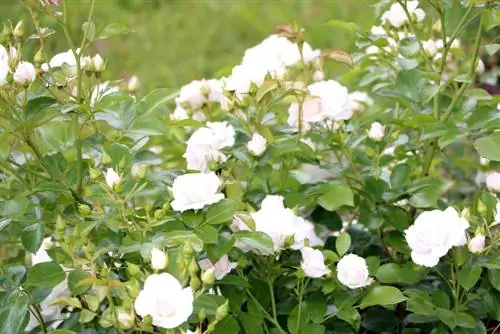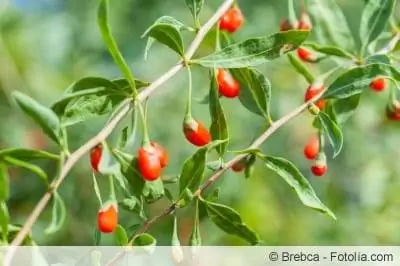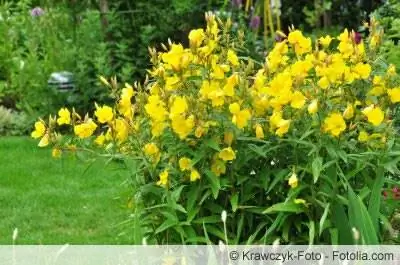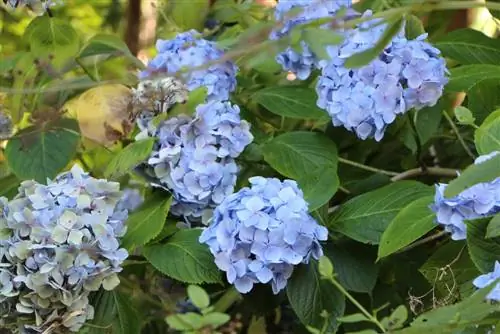- Author admin [email protected].
- Public 2023-12-17 03:39.
- Last modified 2025-01-24 12:45.
The goji berry has the botanical name Lycium barbarum and originally comes from southeastern Europe and Asia. The berries of this exotic shrub have become known for their he alth-promoting properties, which is why it is worth growing them in the garden to improve your own diet. Due to its good frost hardiness, the goji berry can also be grown in this country and can tolerate both cold winter periods and hot summer months. It is important to constantly monitor the growth, as the shrub can quickly grow to large size and cause damage.
Location & plant substrate
If the goji berry is placed in the right location, it will bloom vigorously and produce plenty of fruit. It is important to have a place with sufficient sun and warmth so that the plant can feel comfortable all year round. The nutrient content plays a major role in the planting substrate, and the goji berry also needs permeable soil as it cannot tolerate accumulated moisture. Ideally, the bush can be grown on a horizontal framework, similar to blackberries; the framework ensures better control of wild growth and enables more convenient harvesting. The following aspects must be taken into account when it comes to the location and plant substrate:
- Prefers partially sunny to partially shaded locations
- It is absolutely unacceptable to avoid direct midday heat, it is not tolerated
- Well-dosed sunlight promotes growth
- Make sure conditions are sheltered from the wind
- Undemanding to soil conditions, normal garden soil is sufficient
- Can cope with very light sandy soils
- Also tolerates high s alt concentrations in the soil
- But needs high nutrient content for the berries to develop
- Loosen compacted and impermeable soil before planting
- Install drainage as a precaution to increase permeability
- Cultivation in pots for balconies and terraces possible
- Plan one square meter per plant
- Leave 2 m of space between several Goji plants
- Insert the root ball at the location about 30 cm deep
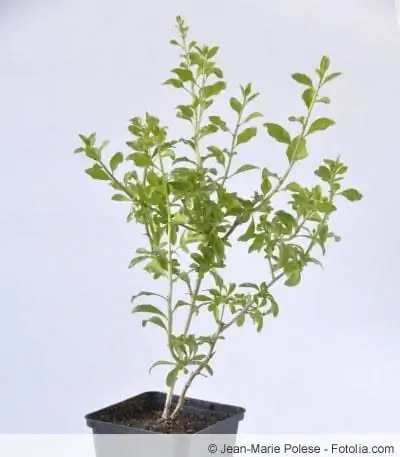
Tip:
When choosing the location, it should be borne in mind that the plant grows quickly and over large areas, so it needs enough space to spread and thrive without problems.
Care
If you want to cultivate the shrub in your garden close to other plants that grow over large areas or on the neighboring property, you should definitely use a root barrier, as the goji berry can spread without any problems. If the cultivation is carried out with the aim of producing a rich harvest, then there is a large selection of already rooted shrubs that are several years old available from specialist retailers. In this case, the first formation of the berries occurs fairly quickly. If the specimen is older and has a larger ball of soil, it can be used at any time of the year as long as the ground is not completely frozen. The following criteria are crucial for care:
- Raising and care are relatively easy
- Use a root barrier that is at least 30 cm deep; strong pond liner is ideal
- The best time to plant is in spring, ideally April to May
- Usually does not bear fruit until the third year of life
- The berries form in the months between August and September
- Harvest takes place in late summer and early autumn
- Older plants are relatively robust and survive even the first night frosts in autumn
- Young specimens enjoy additional frost protection
- Can be cultivated as a bushy shrub
- Can reach heights of 2-4 meters
- Reaches twice the width of the height as it grows
- Alternatively, only one main trunk is left standing
- In this case, a very thick and upright growing branch is selected
- High stem makes access easier during harvesting
Watering & Fertilizing

The goji berry has a normal water requirement, but this increases during extremely hot and dry weather conditions. Regular fertilizer applications are important so that the plant can produce a rich harvest. Ideally, organic fertilizer is used so that no toxins get into the berries, which serve as food:
- Water at least once a week, depending on the frequency of rain
- Avoid waterlogging at all costs, it is not tolerated
- Optimal fertilizer is your own compost
- Nutrient additions are important to keep yields high at harvest
- Incorporate organic fertilizer when planting
- High mineral content in the soil plays an important role in the development of fruit sweetness
Tip:
During the acclimatization period, the goji berry needs a lot of water so that the plant can grow well and without problems.
pruning
Due to its sprawling growth, the shrub can quickly become a nuisance and unintentionally wander over to the neighboring property. Therefore, pruning must be carried out early and, if necessary, extensively. Young shoots can grow several meters in a year and cause nuisance to neighboring plants, buildings and properties. If the shoots are extremely long, the plant uses too much energy to supply them adequately. So that the goji berry has an attractive shape and can produce many fruits, it must be pruned. At the points of pruning, the shrub branches out again and then grows beautifully bushy, instead of criss-crossing without control.
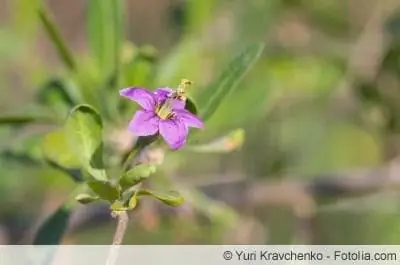
Pruning allows the plant to supply each of its branches with the nutrients it needs and, as a result, produce a large number of fruits:
- Summer green shrub, sprouts arching and overhanging branches
- Shoots form roots as soon as they touch the ground
- Grows and proliferates quickly and often uncontrollably
- Often reaches a height of 1 m in the first year
- Twigs that are too long reduce the development of flowers and fruits
- Prune once or twice a year, depending on the duration and extent of growth
- Ideal times for pruning are in spring and autumn
- Do not leave more than 5-6 shoots on the plant
- Short the length of the shoots to approx. 50-60 cm
- Every cut ensures better branches
- Pruning promotes a bushy and dense appearance
- Remove dead branches in autumn
- The bush bears plenty of fruit in its third year of life
- Do not prune radically after fruit formation
Tip:
The shoots, which are still young and grow quickly, have a tendency to sink to the ground under their own weight and then take root again. However, this shouldn't happen, otherwise it will make controlling the growth more difficult.
Wintering
The goji berry is extremely robust and can survive long and very cold frost periods in the local winters. However, cuttings that are still small must have reached a good size by winter so that they can survive frosts well. Every shrub is happy about additional winter protection to avoid damage from wind and weather:
- Frost hardness down to around -25° C
- Plant is also suitable for higher locations with colder winter phases
- Lay out winter protection in the form of mulch and brushwood
- Does not tolerate overly exposed places, needs wind-protected locations
Diseases & Pests

The goji berry is quickly susceptible to powdery mildew if care is taken incorrectly and the location conditions are incorrect. Although the bush loses its leaves, the infestation has no other negative effects on the berries. In addition, more and more gardeners have reported an infestation with the Asian gall mite in recent years. The following procedures have proven effective against diseases and pests:
- Prone to mildew, can be controlled by cutting back in time
- Dispose of affected branches in household waste, never in the compost
- Only use biological pesticides to combat mildew
- If gall mite infestation occurs, carry out sulfur treatment before sprouting
Conclusion
The goji berry is an exotic-looking shrub that is relatively undemanding and can handle the local conditions well. Since the plant only bears fruit after a few years, either patience or purchasing a perennial specimen is recommended, which guarantees a quick harvest. The extent and quality of crop yields depend heavily on the nutrient content of the soil and the warmth and duration of sunlight at the location. A lean harvest can be compensated for with additional fertilizer applications and good wind and heat protection. Since the goji berry grows quickly and extensively, regular pruning is strongly recommended. Pruning also promotes harvest yields and the level of ingredients, which have many he alth benefits. The goji berry can either be cultivated as a bushy shrub or grown on a standard tree, which makes harvesting easier.


